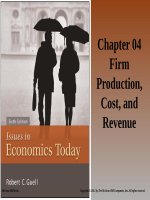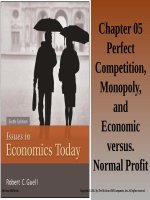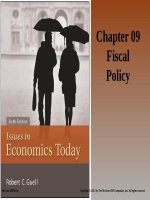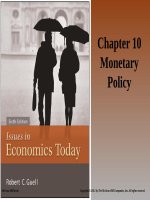Isues in economics today 6th by guell chapter28
Bạn đang xem bản rút gọn của tài liệu. Xem và tải ngay bản đầy đủ của tài liệu tại đây (150.57 KB, 21 trang )
Chapter 28
The
Economics
of Crime
McGraw-Hill/Irwin
Copyright © 2012 by The McGraw-Hill Companies, Inc. All rights reserved.
Chapter Outline
• Who Commits Crime And Why
• The Rational Criminal Model
• The Costs Of Crime
• Optimal Spending On Crime Control
McGraw-Hill/Irwin
©2012 The McGraw-Hill Companies, All Rights Reserved
28-2
1-2
Who Commits Crime and Why
•
Disproportionately to their percentage in the
population crime is committed by
•
•
•
•
Men
The young
The poor
The socially disadvantaged
McGraw-Hill/Irwin
©2012 The McGraw-Hill Companies, All Rights Reserved
28-3
1-3
Sources of Crime Statistics
•
Police reports
• Potentially subject to police
biases against minorities.
•
Victim accounts
• Not subject to bias because it is
in the interest of a victim to give
an accurate description of the
perpetrator.
McGraw-Hill/Irwin
©2012 The McGraw-Hill Companies, All Rights Reserved
28-4
1-4
The Result
•
Whether we look at crime rates from police reports
or from victim accounts the result is the same:
• minorities commit more crime
than would be accounted for
by their 28% of the
population.
McGraw-Hill/Irwin
©2012 The McGraw-Hill Companies, All Rights Reserved
28-5
1-5
The Rational Criminal Model
• Becker’s rational criminal model (RCM)
assumes that a criminal’s choice to
commit a crime is a rational one
comparing the benefits of the crime with
the uncertain outcome of success or jail.
• The model looks at crime like an
investment: take a risk, get a high
expected return; play it safe, get a low
expected return.
McGraw-Hill/Irwin
©2012 The McGraw-Hill Companies, All Rights Reserved
28-6
1-6
Implications of the RCM
• People with high legally-derived income are less likely to
commit crime.
• The greater the punishment the less likely the criminal is
to commit crime.
• The more likely the criminal is to be caught the less likely
they are to commit crime.
McGraw-Hill/Irwin
©2012 The McGraw-Hill Companies, All Rights Reserved
28-7
1-7
Evidence in favor of the RCM
• Less than half of the prison population has a high
school degree.
• 33% of criminals were not working when they
committed their crime.
• Crime rose during the 1980s as real income for the
poor was stagnant or falling and fell during the
1990s when it was rising.
McGraw-Hill/Irwin
©2012 The McGraw-Hill Companies, All Rights Reserved
28-8
1-8
Evidence against the RCM
•
Crime rose during the 1960s when real income for
the poor was rising.
•
Crime was much lower during the 1930s when
incomes were quite low because of the depression.
McGraw-Hill/Irwin
©2012 The McGraw-Hill Companies, All Rights Reserved
28-9
1-9
Challenges to the
Basic Assumptions of the RCM
•
While property and drug crimes can be seen
through the expected “cost-benefit” lens, others
can not:
• e.g. rape, spousal abuse,
assault, school shootings.
• murder for hire is classic RCM
but generally murder is not
for monetary gain.
McGraw-Hill/Irwin
©2012 The McGraw-Hill Companies, All Rights Reserved
28-10
1-10
Costs of Crime
•
$214 billion is currently spent on the criminal justice
system (police, courts and prisons)
•
There are 20 million crimes
• 4.3 million violent
• 15.7 million non-violent
• Approximately 10 million more
are unreported
McGraw-Hill/Irwin
©2012 The McGraw-Hill Companies, All Rights Reserved
28-11
1-11
How Much Does
an Average Crime Cost?
• Types of costs
• Items taken or damaged
• Lost income of victims
• Psychological damage or “pain and
suffering”
• Costs per crime estimates
• Ignoring Pain and Suffering ..$500
• Including Pain and Suffering..
$10,000
McGraw-Hill/Irwin
©2012 The McGraw-Hill Companies, All Rights Reserved
28-12
1-12
Pain and Suffering Calculations
• How much is pain and suffering worth?
• Do you look at
• Costs of psychological care?
• Damage awards from jury trials?
• Can you calculate a dollar value of pain
and suffering
• to the spouse of a murder victim
• a rape victim.
• Some economists measure the cost of
crime avoidance and use the reciprocal
of the crime reduction fraction to
estimate “what you are willing to pay”
to avoid being a crime victim.
McGraw-Hill/Irwin
©2012 The McGraw-Hill Companies, All Rights Reserved
28-13
1-13
How Much Crime
Does an Average Criminal Commit
•
Estimates from criminologists vary from a 10 to 180.
•
Economists use a conservative 10 to 20 to estimate
the usefulness of crime control.
McGraw-Hill/Irwin
©2012 The McGraw-Hill Companies, All Rights Reserved
28-14
1-14
The Net Result on the Question of
How Much Crime Costs
• At 10 crimes per year and $500 per crime each
criminal commits $5,000 worth of crime each year he
is not in jail.
• At 20 crimes per year and $10,000 per crime each
criminal commits $200,000 worth of crime each year
he is not in jail.
McGraw-Hill/Irwin
©2012 The McGraw-Hill Companies, All Rights Reserved
28-15
1-15
Optimal Spending on Crime
Control
• While the “average” criminal may
commit $200,000 worth of crime and it
costs only $28,750 per year to keep
them in prison, that is not what an
economist would use to make the case.
• An economist would look at the benefit
of locking up one additional criminal and
compare that to the marginal cost of
doing so. This is called Marginal
Analysis.
McGraw-Hill/Irwin
©2012 The McGraw-Hill Companies, All Rights Reserved
28-16
1-16
Are the Right People in Jail?
• More than half of the prison population in many states is
incarcerated for drug crimes.
• Does it make sense to have a nonviolent person in
prison?
McGraw-Hill/Irwin
©2012 The McGraw-Hill Companies, All Rights Reserved
28-17
1-17
What Matters in Crime Control
• What is thought to
Matter and Doesn’t
• Community Policing
• Gun Buybacks
• Death Penalty
• What is Thought
to Matter and
Does
• Number of Police
• Number in Jail
Abortion or Lead?
•Economist Steven Levitt argues that legalization of abortion decreased
unwantedness in the 1970s which led to a decrease in crime in the 1990s. He
argues that these not-born children did not grow up to be mischievous and
criminal adults.
•Economists Jessica Reyes argues that eliminating lead in paint and gasoline
reduced atmospheric lead. When ingested by children, lead decreases their
ability as young adults to avoid impetuous behavior.
McGraw-Hill/Irwin
©2012 The McGraw-Hill Companies, All Rights Reserved
28-18
1-18
What Laws Should
we Rigorously Enforce
• The marginal benefit of arresting all
murderers or rapists is greater than the
marginal benefit of arresting all
recreational drug users and jaywalkers.
• The marginal cost of arresting only
murders and rapists is less than the
marginal cost of arresting all drug users
and jaywalkers.
• Economists compare the marginal cost
and the marginal benefit of targeting
particular crimes.
McGraw-Hill/Irwin
©2012 The McGraw-Hill Companies, All Rights Reserved
28-19
1-19
Marginal Cost and Marginal
Benefit
Marginal Costs
Marginal Benefits
MC
MB
Murders, Rapists, Drug Dealers, Drug Users, Jaywalkers
McGraw-Hill/Irwin
©2012 The McGraw-Hill Companies, All Rights Reserved
28-20
1-20
What is the Optimal Sentence?
• Death Penalty vs. Life in Prison without Parole
• Death Penalty Costs
• Present value of extra adjudication
• Dollar value of executing the innocent
• Life without Parole Costs
• Present value of housing costs
• Present value of medical costs for an aged inmate.
• Economists generally agree that in monetary terms, the death
penalty costs more than life in prison.
• Length of Sentence
• As sentences get longer
• the marginal costs of adding another year to a sentence
grow (because of medical costs),
• the benefits decrease (because the older you are the less
likely you are to commit crime.
McGraw-Hill/Irwin
©2012 The McGraw-Hill Companies, All Rights Reserved
28-21
1-21









